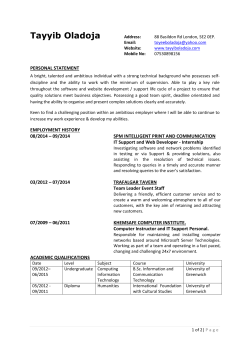
presentation
Azure VM Performance Considerations Running SQL Server Your company logo here Vinod Kumar M @vinodk_sql http://blogs.ExtremeExperts.com Session Objectives And Takeaways Session Objective(s): Learn the performance characteristics of running SQL Server on Windows Azure VM (IaaS) Understand the performance best practices for running SQL Server on Windows Azure VM Key Takeaway 1 What impacts performance of SQL Server running on Windows Azure VM Key Takeaway 2 How to monitor and troubleshoot performance of SQL Server running on Windows Azure VM Performance tuning • Analyzing performance impact – Is it a problem with my SQL application? or – Is it a problem with how I configured the Azure IaaS platform for my usage Key SQL Server Performance Considerations Windows Azure IaaS Characteristics Best Practices Monitoring Key SQL Server Performance Considerations • KPIs – Throughput – Response time (aka latency) Metric OLTP DW Read/Write mix • • • Large number of small transactions Transactions are mostly similar in pattern Significant amount of reads • • Between 8 and 64K Mostly random • • IO size and pattern • • • # users high low Transaction Log Scan intensive, large portions of data at a time Bulk loading • • Mostly writes Requires low latency 1 64KB read per 8 512KB reads Mostly sequential MB/s a critical metric • Highly sequential n/a Windows Azure VM Characteristics Architecture Latency Variability Configuration options VM Configuration Options Virtual Machine size Network bandwidth Disk types and configurations Disk cache settings VM Disk Types & Configurations • OS disk (persistent) – 127GB disk optimized for OS access patterns (e.g. boot up) • Data disk (persistent) – A VHD you can attach to a VM to store app data – Up to 1TB in size – Up to 16 disks for XL VMs • Temporary local disk (non-persistent) – Used for transient/temporary data storage & OS page files – Hosted in attached disks on physical host – Cleaned up in the event of a VM failure or recycling – Physical disks shared across other VMs on same physical machine – Not recommended for user or system database files What are Disk Caching Best Practices for SQL Server? OS Disk • “Read Write” (default) reduces read latency for IO intensive workloads with smaller DBs (<=10GB) – Working set can fit in disk cache or memory, reducing blob storage IO Data disks • Cache setting depends on the IO pattern and workload intensity • Use default of “None” (disable) for higher rate of random IOs (e.g. OLTP) & higher throughput – Bypasses physical host local disks, maximizing IO rate • Consider enabling read cache for latency sensitive read heavy workloads Best Practices Network Latency Disk configuration TempDB placement IO optimization Should TEMPDB go on D: drive? • • • • Short answer: No Long answer: No Why? Predictable performance: OS or data disk can provide same or better performance but D: drive can be more variable, being a physical disk sharing IO with other VMs on the host. Size and performance also depends on VM size • Configuration overhead: SQL Server has to recreate TEMPDB in D: if VM goes down – SQL Server service account requires Admin privileges. If stored in a separate folder this needs to be created at startup. • TEMPDB can be critical to application performance – Follow tempDB IO best practices Instant File Initialization Recommendations • Pre-size all database files appropriately – Autogrow is insurance – Not a license for drunk driving • Configure Instant File Initialization before creating database • Configure Instant File Initialization before extending files. Example: TEMPDB • Configure Instant File Initialization before restoring database on a new server • Don’t forget to restart SQL Server after configuring Instant File Initialization What else to consider for data disk performance? • Disk warm-up • NTFS Allocation Unit Size ? • Single vs. multiple storage accounts with a single VM – DO NOT SPREAD DATA FILES OF A SINGLE DATABASE INTO MULTIPLE STORAGE ACCOUNTS !!! • Data in different blobs not written at the same time • BLOBs that make up the stripe set could be out of sync – Instead: • Spread the data files across multiple disks to achieve higher IOPS / bandwidth – Note: a storage account has a limit of 20K tps Performance Monitoring & Troubleshooting Key tools Storage Analytics VM Dashboard SQL Perf counters Conclusions • Read the Performance Guidance for SQL Server in Windows Azure Virtual Machines white paper • Plan and test for IO perf variability • Identify optimal VM size • Optimize for reduced IO and network round trips • Use Filegroups and multiple data disks for large DBs • Identify your KPIs to monitor • Revisit optimization decisions as workload changes
© Copyright 2025












